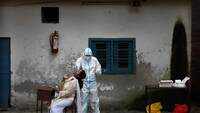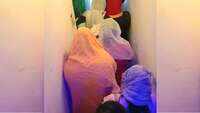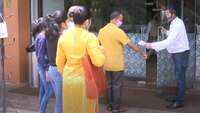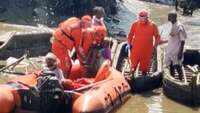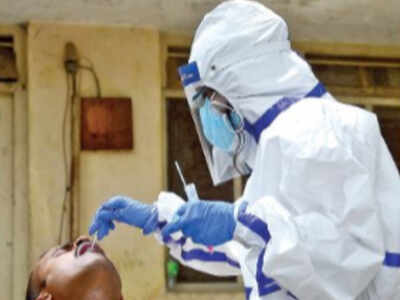
BENGALURU: About 17% of symptomatic individuals who were found negative for Covid-19 in rapid antigen tests (RAT) have tested positive in follow-up RT-PCR tests in Karnataka.
Between June 6 and August 30, over 8.1 lakh rapid antigen tests were conducted in the state and of them, 92,199 people with symptoms were found negative. In follow-up real time polymerase chain reaction (RT-PCR) tests for 93,371 people, 16,048 or 17% tested positive.
Asked why the number of symptomatic individuals who underwent RT-PCR tests is more than those testing negative in RAT, officials said this is because many of them would have developed symptoms post collection of samples.
“Daily phone calls are made to ensure persons testing negative in RAT don’t miss out on the RTPCR test,” said Shalini Rajneesh, additional chief secretary and in-charge of testing for Covid-19.
However, there is a lot of variation at the districtlevel in follow-up RT-PCR tests. Data shared by the government shows 79% of symptomatic Bengalureans have undergone RT-PCR test after being found negative in RAT as on August 30.
In fact, as on August 26, data shows 75,861 repeat follow-up RT-PCR tests were conducted for 85,934 symptomatic RAT negative people. However for various reasons, close to 10,000 such symptomatic people who tested negative in RAT had not been covered by the follow-up RTPCR tests. Medical officers suspect they could be superspreaders.
However, by August 30, the number of follow up RTPCRs touched 93,371.
As per rules, those with symptoms who test negative with RAT must compulsorily undergo RT-PCR tests. Rajneesh said personnel on the field collect two swabs per person to ensure the follow-up test is conducted. She said the reason for the earlier gap was because ICMR portal did not provide for real- time linkage of RAT and RT-PCR test.
“As a result lab technicians would generate one sample registration form id (SRFID) for a person on the spot. If he or she is symptomatic but were RAT negative, the other nasal swab would then be sent for RTPCR test. Thus the lab would generate another SRFID,” she said.
Now, the system has improved, she said, adding: “ICMR has fully operationalised the data upload of RAT. Within half-an-hour of the RAT test, the same SRFID can be used by the lab for RT-PCR. This will ensure a 100% follow up of symptomatic RAT negative tests on the portal.”
Dr CN Manjunath, nodal officer (testing) on the state’s task force, said despite RAT being negative, some percentage of people could be positive. “RAT weeds out 50% of suspects. It tremendously reduces the RT-PCR load. Though sensitivity of RAT is 50-60 %, its specificity in case of a positive patient is 100%. RAT ensures some cases are segregated only for RTPCR. It helps prevent spread of the virus while enabling early diagnosis,” he said. “RT-PCR tests have increased. On August 29 alone, we conducted as many as 45,000 RT-PCR tests and close to 25,000 RAT tests,” he added.
Between June 6 and August 30, over 8.1 lakh rapid antigen tests were conducted in the state and of them, 92,199 people with symptoms were found negative. In follow-up real time polymerase chain reaction (RT-PCR) tests for 93,371 people, 16,048 or 17% tested positive.
Asked why the number of symptomatic individuals who underwent RT-PCR tests is more than those testing negative in RAT, officials said this is because many of them would have developed symptoms post collection of samples.
“Daily phone calls are made to ensure persons testing negative in RAT don’t miss out on the RTPCR test,” said Shalini Rajneesh, additional chief secretary and in-charge of testing for Covid-19.
However, there is a lot of variation at the districtlevel in follow-up RT-PCR tests. Data shared by the government shows 79% of symptomatic Bengalureans have undergone RT-PCR test after being found negative in RAT as on August 30.
In fact, as on August 26, data shows 75,861 repeat follow-up RT-PCR tests were conducted for 85,934 symptomatic RAT negative people. However for various reasons, close to 10,000 such symptomatic people who tested negative in RAT had not been covered by the follow-up RTPCR tests. Medical officers suspect they could be superspreaders.
However, by August 30, the number of follow up RTPCRs touched 93,371.
As per rules, those with symptoms who test negative with RAT must compulsorily undergo RT-PCR tests. Rajneesh said personnel on the field collect two swabs per person to ensure the follow-up test is conducted. She said the reason for the earlier gap was because ICMR portal did not provide for real- time linkage of RAT and RT-PCR test.
“As a result lab technicians would generate one sample registration form id (SRFID) for a person on the spot. If he or she is symptomatic but were RAT negative, the other nasal swab would then be sent for RTPCR test. Thus the lab would generate another SRFID,” she said.
Now, the system has improved, she said, adding: “ICMR has fully operationalised the data upload of RAT. Within half-an-hour of the RAT test, the same SRFID can be used by the lab for RT-PCR. This will ensure a 100% follow up of symptomatic RAT negative tests on the portal.”
Dr CN Manjunath, nodal officer (testing) on the state’s task force, said despite RAT being negative, some percentage of people could be positive. “RAT weeds out 50% of suspects. It tremendously reduces the RT-PCR load. Though sensitivity of RAT is 50-60 %, its specificity in case of a positive patient is 100%. RAT ensures some cases are segregated only for RTPCR. It helps prevent spread of the virus while enabling early diagnosis,” he said. “RT-PCR tests have increased. On August 29 alone, we conducted as many as 45,000 RT-PCR tests and close to 25,000 RAT tests,” he added.
Quick Links
Kerala Coronavirus Helpline NumberHaryana Coronavirus Helpline NumberUP Coronavirus Helpline NumberBareilly NewsBhopal NewsCoronavirus in DelhiCoronavirus in HyderabadCoronavirus in IndiaCoronavirus symptomsCoronavirusRajasthan Coronavirus Helpline NumberAditya ThackerayShiv SenaFire in MumbaiAP Coronavirus Helpline NumberArvind KejriwalJammu Kashmir Coronavirus Helpline NumberSrinagar encounter
Get the app

